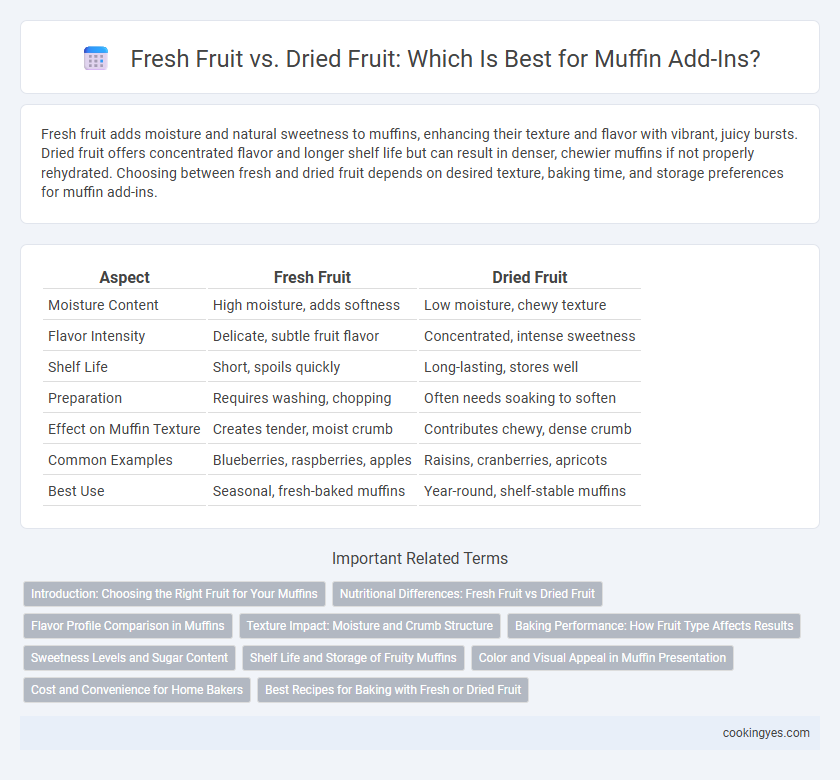Fresh fruit adds moisture and natural sweetness to muffins, enhancing their texture and flavor with vibrant, juicy bursts. Dried fruit offers concentrated flavor and longer shelf life but can result in denser, chewier muffins if not properly rehydrated. Choosing between fresh and dried fruit depends on desired texture, baking time, and storage preferences for muffin add-ins.
Table of Comparison
| Aspect | Fresh Fruit | Dried Fruit |
|---|---|---|
| Moisture Content | High moisture, adds softness | Low moisture, chewy texture |
| Flavor Intensity | Delicate, subtle fruit flavor | Concentrated, intense sweetness |
| Shelf Life | Short, spoils quickly | Long-lasting, stores well |
| Preparation | Requires washing, chopping | Often needs soaking to soften |
| Effect on Muffin Texture | Creates tender, moist crumb | Contributes chewy, dense crumb |
| Common Examples | Blueberries, raspberries, apples | Raisins, cranberries, apricots |
| Best Use | Seasonal, fresh-baked muffins | Year-round, shelf-stable muffins |
Introduction: Choosing the Right Fruit for Your Muffins
Fresh fruit offers vibrant flavor and moisture that enhances muffin texture, while dried fruit provides concentrated sweetness and a chewy bite. Selecting between fresh and dried fruit depends on desired muffin consistency, shelf life, and flavor intensity. Popular fresh options include blueberries and raspberries, whereas raisins and dried cranberries are common dried choices.
Nutritional Differences: Fresh Fruit vs Dried Fruit
Fresh fruit adds hydration and fewer calories to muffins, offering higher vitamin C content and natural antioxidants. Dried fruit is calorie-dense, rich in fiber, and provides concentrated natural sugars, enhancing shelf life without moisture. Incorporating fresh fruit improves freshness and nutritional hydration, while dried fruit boosts fiber and sweetness intensity.
Flavor Profile Comparison in Muffins
Fresh fruit in muffins provides a juicy, vibrant flavor and natural sweetness that enhances moistness and adds a burst of freshness. Dried fruit offers a concentrated, richer taste with chewy texture and intensified sweetness, which can create pockets of rich flavor throughout the muffin. Balancing fresh and dried fruit allows for a complex flavor profile, combining juicy brightness with deep, caramelized notes.
Texture Impact: Moisture and Crumb Structure
Fresh fruit in muffins contributes to a moist texture and tender crumb due to its high water content, which softens the batter during baking. Dried fruit, lacking moisture, creates a denser crumb and adds chewiness while concentrating natural sugars for intense flavor bursts. Balancing fresh and dried fruit influences the overall muffin structure, affecting bite consistency and shelf life.
Baking Performance: How Fruit Type Affects Results
Fresh fruit in muffins provides higher moisture content, resulting in a tender crumb and softer texture, but may release extra water that can extend baking time and affect rise. Dried fruit offers concentrated sweetness and firmer texture, helping maintain batter consistency and promoting even baking, though it can sometimes cause dryness if not properly rehydrated. Choosing between fresh and dried fruit impacts muffin density, crumb structure, and overall moisture balance during the baking process.
Sweetness Levels and Sugar Content
Fresh fruit in muffins offers natural sweetness with lower sugar concentration, enhancing moisture and providing a vibrant flavor profile. Dried fruit, such as raisins or apricots, contains concentrated sugars that increase overall sweetness and can lead to a denser texture. Choosing between fresh and dried fruits impacts not only sugar content but also the muffin's texture and moisture balance.
Shelf Life and Storage of Fruity Muffins
Fresh fruit in muffin add-ins enhances flavor and moisture but shortens shelf life due to higher water content, requiring refrigeration and consumption within 2-3 days. Dried fruit extends shelf life significantly, allowing fruity muffins to be stored at room temperature for up to a week without spoilage. Proper airtight packaging is essential for both types to maintain texture and prevent staleness during storage.
Color and Visual Appeal in Muffin Presentation
Fresh fruit add-ins in muffins provide vibrant colors like deep reds from strawberries or bright blues from blueberries, enhancing visual appeal and making each bite look more enticing. Dried fruit, while offering concentrated sweetness and chewy texture, often appears duller with muted tones such as brown raisins or apricot pieces, which can reduce overall muffin vibrancy. Incorporating fresh fruit ensures a visually striking muffin display, crucial for attracting attention in bakery presentations and food photography.
Cost and Convenience for Home Bakers
Fresh fruit offers vibrant flavor and moisture for muffins but often comes at a higher cost and requires quick use to avoid spoilage. Dried fruit, while less perishable and more budget-friendly, provides concentrated sweetness and longer shelf life, making it convenient for home bakers who prefer minimal prep and waste. Choosing between fresh and dried fruit depends on balancing expense, flavor preference, and time management in muffin preparation.
Best Recipes for Baking with Fresh or Dried Fruit
Fresh fruit add-ins like blueberries and raspberries provide natural moisture and vibrant flavor, making muffins tender and juicy. Dried fruit options such as raisins, cranberries, or chopped apricots offer concentrated sweetness and a chewy texture that holds up well during baking. The best muffin recipes balance fresh and dried fruits to enhance taste and texture, often pairing fresh fruit in the batter with dried fruit sprinkled on top for optimal flavor contrast.
Fresh fruit vs dried fruit for muffin add-ins Infographic

 cookingyes.com
cookingyes.com